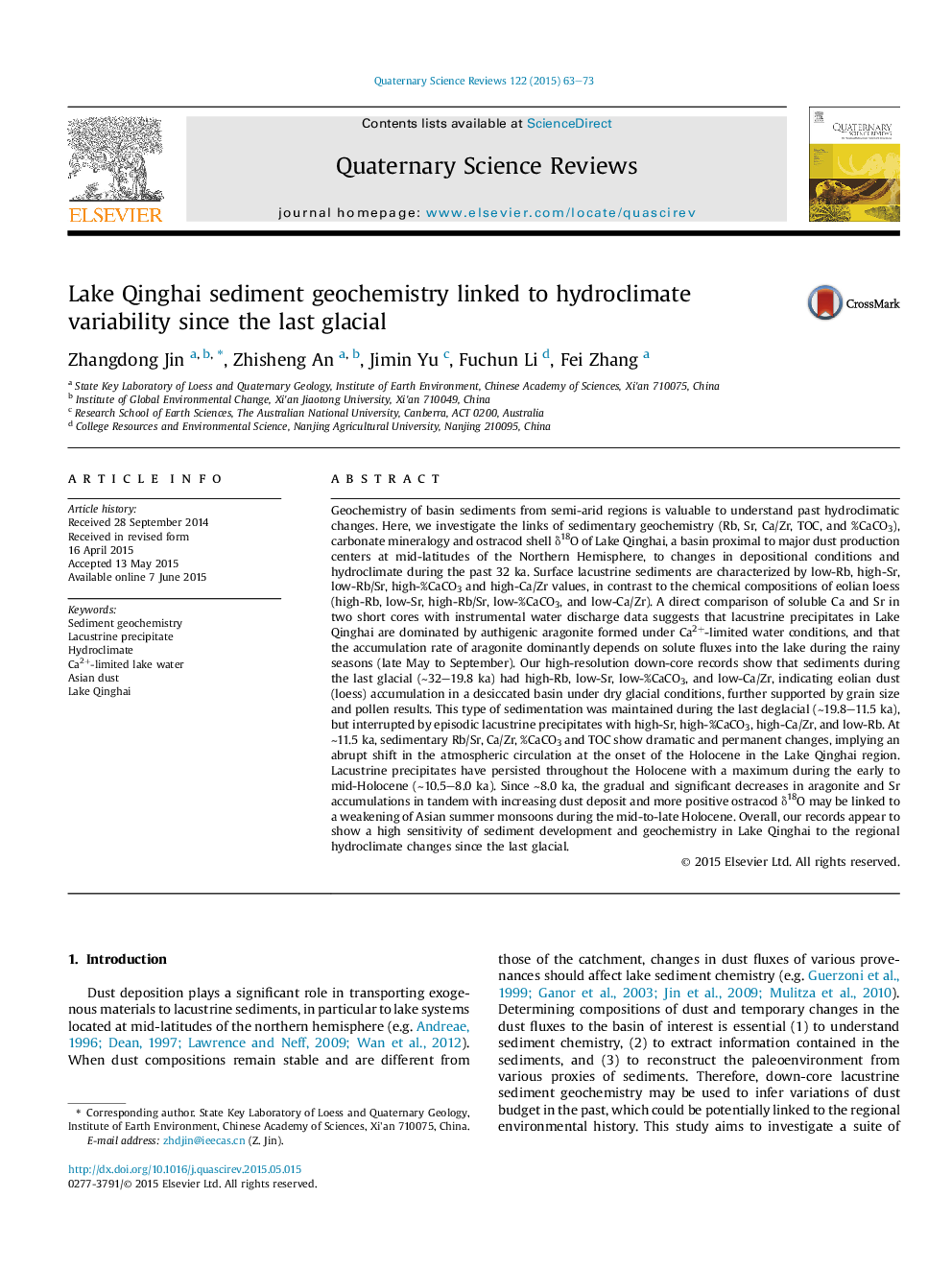| کد مقاله | کد نشریه | سال انتشار | مقاله انگلیسی | نسخه تمام متن |
|---|---|---|---|---|
| 6445853 | 1640812 | 2015 | 11 صفحه PDF | دانلود رایگان |
عنوان انگلیسی مقاله ISI
Lake Qinghai sediment geochemistry linked to hydroclimate variability since the last glacial
ترجمه فارسی عنوان
ژئوشیمی رسوبی دریاچه چینگهای به دلیل تغییرات هیدروکلمیسم از زمان یخبندان گذشته است
دانلود مقاله + سفارش ترجمه
دانلود مقاله ISI انگلیسی
رایگان برای ایرانیان
کلمات کلیدی
موضوعات مرتبط
مهندسی و علوم پایه
علوم زمین و سیارات
زمین شناسی
چکیده انگلیسی
Geochemistry of basin sediments from semi-arid regions is valuable to understand past hydroclimatic changes. Here, we investigate the links of sedimentary geochemistry (Rb, Sr, Ca/Zr, TOC, and %CaCO3), carbonate mineralogy and ostracod shell δ18O of Lake Qinghai, a basin proximal to major dust production centers at mid-latitudes of the Northern Hemisphere, to changes in depositional conditions and hydroclimate during the past 32 ka. Surface lacustrine sediments are characterized by low-Rb, high-Sr, low-Rb/Sr, high-%CaCO3 and high-Ca/Zr values, in contrast to the chemical compositions of eolian loess (high-Rb, low-Sr, high-Rb/Sr, low-%CaCO3, and low-Ca/Zr). A direct comparison of soluble Ca and Sr in two short cores with instrumental water discharge data suggests that lacustrine precipitates in Lake Qinghai are dominated by authigenic aragonite formed under Ca2+-limited water conditions, and that the accumulation rate of aragonite dominantly depends on solute fluxes into the lake during the rainy seasons (late May to September). Our high-resolution down-core records show that sediments during the last glacial (â¼32-19.8 ka) had high-Rb, low-Sr, low-%CaCO3, and low-Ca/Zr, indicating eolian dust (loess) accumulation in a desiccated basin under dry glacial conditions, further supported by grain size and pollen results. This type of sedimentation was maintained during the last deglacial (â¼19.8-11.5 ka), but interrupted by episodic lacustrine precipitates with high-Sr, high-%CaCO3, high-Ca/Zr, and low-Rb. At â¼11.5 ka, sedimentary Rb/Sr, Ca/Zr, %CaCO3 and TOC show dramatic and permanent changes, implying an abrupt shift in the atmospheric circulation at the onset of the Holocene in the Lake Qinghai region. Lacustrine precipitates have persisted throughout the Holocene with a maximum during the early to mid-Holocene (â¼10.5-8.0 ka). Since â¼8.0 ka, the gradual and significant decreases in aragonite and Sr accumulations in tandem with increasing dust deposit and more positive ostracod δ18O may be linked to a weakening of Asian summer monsoons during the mid-to-late Holocene. Overall, our records appear to show a high sensitivity of sediment development and geochemistry in Lake Qinghai to the regional hydroclimate changes since the last glacial.
ناشر
Database: Elsevier - ScienceDirect (ساینس دایرکت)
Journal: Quaternary Science Reviews - Volume 122, 15 August 2015, Pages 63-73
Journal: Quaternary Science Reviews - Volume 122, 15 August 2015, Pages 63-73
نویسندگان
Zhangdong Jin, Zhisheng An, Jimin Yu, Fuchun Li, Fei Zhang,
